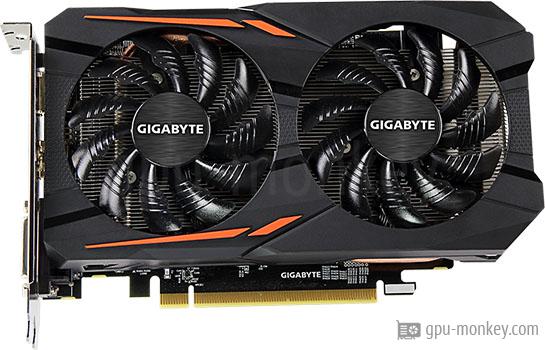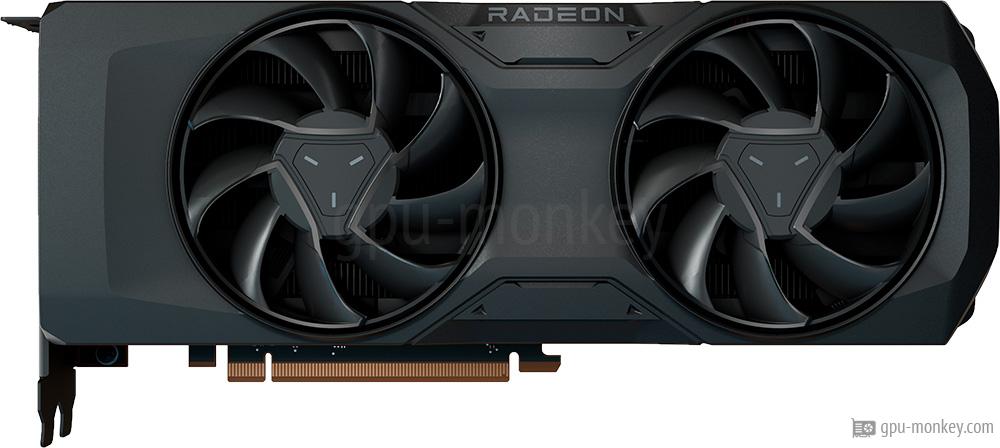GIGABYTE Radeon RX 560 Gaming OC 4G (rev. 1.0)
vs
AMD Radeon RX 7800 XT
GPU comparison with benchmarksThe GIGABYTE Radeon RX 560 Gaming OC 4G (rev. 1.0) has 1024 shader units and these clock a maximum of 1.30 GHz which results in an FP32 computing power of 2.38 TFLOPS.
The AMD Radeon RX 7800 XT has 3840 shader units and these clock at a maximum of 2.43 GHz and achieve an FP32 computing power of 37.32 TFLOPS. |
||
GPUThe GIGABYTE Radeon RX 560 Gaming OC 4G (rev. 1.0) is equipped with a graphics chip of the GCN 4 architecture, which has 16 streaming multiprocessors. The graphics card AMD Radeon RX 7800 XT is based on the RDNA 3 architecture and is equipped with 60 execution units. |
||
| GIGABYTE Radeon RX 560 Gaming OC 4G (rev. 1.0) | GPU | AMD Radeon RX 7800 XT |
| AMD Radeon RX 560 (16 CU) | Based on | AMD Radeon RX 7800 XT |
| Polaris 21 XT | GPU Chip | Navi 32 XT |
| GCN 4 | Architecture | RDNA 3 |
| 16 | Streaming Multiprocessors | 60 |
| 1024 | Shader | 3840 |
| 16 | Render Output Units | 96 |
| 64 | Texture Units | 240 |
| 0 | Raytracing Cores | 60 |
MemoryThe GIGABYTE Radeon RX 560 Gaming OC 4G (rev. 1.0) is equipped with a 4 GB large GDDR5 graphics memory, which is equipped with 1.750 GHz clocks. The AMD Radeon RX 7800 XT has a 16 GB large GDDR6 graphics memory and the memory clock is 2.438GHz. |
||
| 4 GB | Memory Size | 16 GB |
| GDDR5 | Memory Type | GDDR6 |
| 1.750 GHz | Memory Clock | 2.438 GHz |
| 7.0 Gbps | Memory Speed | 19.5 Gbps |
| 112 GB/s | Memory bandwidth | 624 GB/s |
| 128 bit | Memory Interface | 256 bit |
Clock SpeedsThe GIGABYTE Radeon RX 560 Gaming OC 4G (rev. 1.0) has a turbo clock of 1.300 GHz. The turbo frequency of the AMD Radeon RX 7800 XT is 2.430 GHz. |
||
| 1.199 GHz | Base Clock | 1.800 GHz |
| 1.300 GHz | Boost Clock | 2.430 GHz |
| 1.29 GHz | Avg (Game) Clock | 2.12 GHz |
| Yes | Overclocking | Yes |
Thermal DesignThe GIGABYTE Radeon RX 560 Gaming OC 4G (rev. 1.0) has 1 x 6-Pin connectors through which it is supplied with power. The manufacturer specifies the maximum operating temperature of the graphics card as 97 °C. The AMD Radeon RX 7800 XT is equipped with a 2 x 8-Pin PCIe power connector that supplies it with power. The maximum operating temperature of the card is 96 °C. |
||
| 75 W | TDP | 263 W |
| -- | TDP (up) | -- |
| 97 °C | Tjunction max | 96 °C |
| 1 x 6-Pin | PCIe-Power | 2 x 8-Pin |
Cooler & FansThe graphics processor and graphics memory of the GIGABYTE Radeon RX 560 Gaming OC 4G (rev. 1.0) are cooled with a Air cooling. The AMD Radeon RX 7800 XT is cooled by a Air cooling. |
||
| Axial | Fan-Type | Axial |
| 2 x 80 mm | Fan 1 | 2 x 90 mm |
| -- | Fan 2 | -- |
| Air cooling | Cooler-Type | Air cooling |
| 0 dB | Noise (Idle) | 0 dB |
| -- | Noise (Load) | -- |
ConnectivityThe GIGABYTE Radeon RX 560 Gaming OC 4G (rev. 1.0) supports the downward compatible copy protection HDCP in version 2.2. The AMD Radeon RX 7800 XT supports HDCP in version 2.3 and all previous versions. |
||
| 4 | Max. Displays | 4 |
| 2.2 | HDCP-Version | 2.3 |
| 1x HDMI v2.0b | HDMI Ports | 1x HDMI v2.1a |
| 1x DP v1.4 | DP Ports | 3x DP v2.1 |
| 1 | DVI Ports | -- |
| -- | VGA Ports | -- |
| -- | USB-C Ports | -- |
FeaturesetThe GIGABYTE Radeon RX 560 Gaming OC 4G (rev. 1.0) supports the DirectX standard from Microsoft in version 12. The AMD Radeon RX 7800 XT supports Microsoft's DirectX version 12_2 (Ultimate). |
||
| 5120x2880 | Max. resolution | 7680x4320 |
| 12 | DirectX | 12_2 (Ultimate) |
| No | Raytracing | Yes |
| Yes | DLSS / FSR | Yes |
| No LED lighting | LED | Addressable LED |
Supported Video CodecsThis area lists which video codecs can be decoded or encoded by the graphics cards in hardware. As a result, the power consumption can be reduced due to a lower processor load. |
||
| Decode / Encode | h264 | Decode / Encode |
| Decode / Encode | h265 / HEVC | Decode / Encode |
| No | AV1 | Decode / Encode |
| Decode | VP8 | Decode / Encode |
| Decode | VP9 | Decode / Encode |
DimensionsThe GIGABYTE Radeon RX 560 Gaming OC 4G (rev. 1.0) is 37 mm wide and therefore needs the space of 3 PCIe-Slots in the case. The width of the AMD Radeon RX 7800 XT is 37 mm and thus requires the space of 3 PCIe-Slots in the PC case. |
||
| 190 mm | Length | 267 mm |
| 111 mm | Height | 135 mm |
| 37 mm | Width | 50 mm |
| 2 PCIe-Slots | Width (Slots) | 3 PCIe-Slots |
| -- | Weight | -- |
| PCIe 3.0 x 8 | GPU Interface | PCIe 4 x 16 |
Additional dataManufactured using the 14 nanometer process, GIGABYTE Radeon RX 560 Gaming OC 4G (rev. 1.0) was released in Q2/2017. The AMD Radeon RX 7800 XT published in Q3/2023 is manufactured with a structure width of 5 nanometers. |
||
| GV-RX560GAMING OC-4GD | Part-no | -- |
| Q2/2017 | Release date | Q3/2023 |
| 99 $ (Reference) | Launch Price | 499 $ |
| 14 nm | Structure size | 5 nm |
| data sheet | Documents | data sheet |
Rate these graphics cards now
Benchmark results
3DMark Benchmark (DirectX, Raytracing)
3DMark is a benchmark program that determines the performance of certain components of a computer and then reports the performance as a numerical value.
Time Spy Extreme Graphics score
|
|
GIGABYTE Radeon RX 560 Gaming OC 4G (rev. 1.0)
4 GB GDDR5 |
||
|
|
AMD Radeon RX 7800 XT
16 GB GDDR6 |
||
The Last of Us Part 1
The Last of Us Part One is a game released by Sony in June 2013 exclusively for the Playstation and released for the PC in early 2023. The benchmark values here were determined at high details.
3840x2160 (2160p)
|
|
AMD Radeon RX 7800 XT
16 GB GDDR6 |
||
2560x1440 (1440p)
|
|
AMD Radeon RX 7800 XT
16 GB GDDR6 |
||
1920x1080 (1080p)
|
|
AMD Radeon RX 7800 XT
16 GB GDDR6 |
||
Battlefield 5
Battlefield 5 is a visually stunning game that is ideal as a graphics card benchmark. We test the game with maximum details on Windows 10.
3840x2160 (2160p)
2560x1440 (1440p)
1920x1080 (1080p)
Geekbench 6 (OpenCL, Vulkan, Metal)
Geekbench 6 is a cross-platform benchmark for main processors, which also carries out 3 different graphics benchmarks and outputs them in the form of a numerical value.
Geekbench 6 - OpenCL
|
|
GIGABYTE Radeon RX 560 Gaming OC 4G (rev. 1.0)
4 GB GDDR5 |
||
|
|
AMD Radeon RX 7800 XT
16 GB GDDR6 |
||
Geekbench 6 - Vulkan
|
|
GIGABYTE Radeon RX 560 Gaming OC 4G (rev. 1.0)
4 GB GDDR5 |
||
|
|
AMD Radeon RX 7800 XT
16 GB GDDR6 |
||
Geekbench 6 - Metal
FP32 Performance (Single-precision TFLOPS)
The theoretical computing power of the graphics card with single precision (32 bit) in TFLOPS indicates how many trillion FP32 floating point operations the graphics card (GPU) can perform per second.
FP32 (TFLOPS)
|
|
GIGABYTE Radeon RX 560 Gaming OC 4G (rev. 1.0)
4 GB GDDR5 |
||
|
|
AMD Radeon RX 7800 XT
16 GB GDDR6 |
||





